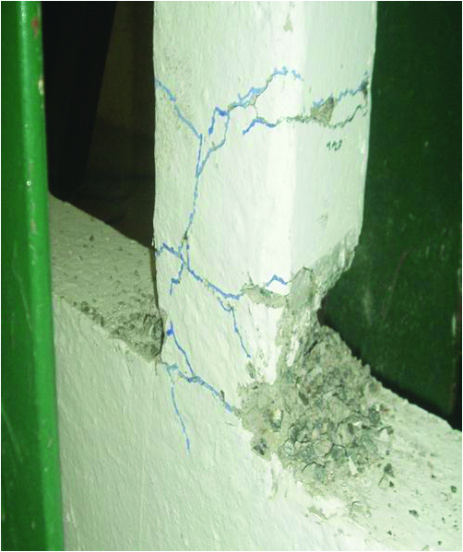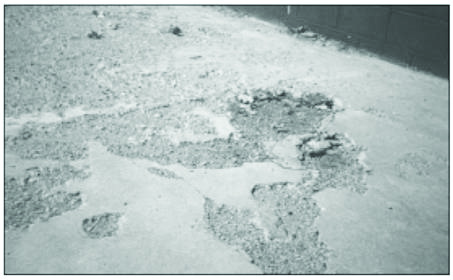| Mr. Debasish Verma Senior Consultant ( Bridges A. Infrastructure Consultants Pvt. Ltd. |
|
| Mr. Kashinath Chatterjee Director – Technical Ado Additives Mfg. Pvt. Ltd. |
Durability and life is the prime requirement of the structures built. This stride remains the foremost problem that we are facing today whether it is a simple building or industrial plant, bridge, jetty, dam and so on. In addition, there is an imminent need for upgrading and retrofitting of existing structures viz. roads and bridges, revamping of power plants and other important structures. This situation has generated the need for introspection in this area.
(i) Cosmetic, superficial, patch repair
(ii) Principal and major structural repair. Structural distress may occur due to
- Inadequate or erroneous design and improper workmanship
- Correctly designed and built but subjected to unforeseeable severe stressing
- Correctly designed and built but not meeting the present criteria of design.
Rectification measures for structural defects and inadequacies call for repair along with strengthening or retrofitting. Other types of defects due to improper construction are variation in shape, honeycombing, shrinkage, cracks, inadequate cover and so on and some other defects like normal wear and tear, ageing and weathering due to severity of environment. Defects can occur also due to fire damage.
Rectification measures for such condition call for repair as well as safeguard against damage through appropriate inhibitive or protective measures. The decision regarding remedial measures can be befitting only through proper distress assessment, evaluation of causes of defects and distress specific case diagnosis can only lead to proper selection of mitigation measures, repair material methodology, which will be the most appropriate and most effective. Therefore, the determining criteria to decide the rehabilitation measures will be:
– Actual state of the component and evaluation of distress through proper diagnosis
– Causes of deterioration and distress
– Desired working properties after rehabilitation
– Economic criteria i.e., immediate and life cycle cost
The most effective repair technique will be permanent repair solution, which will cut down increasingly frequent repair cycle. In some cases, immediate or intermediate measures may be necessary, followed by permanent long-term rectification, urgency of repair travisdmathews, short term measures and permanent solutions, which will be rather determined by the nature and magnitude of the defect and its causes. Type of remedial measures depends on whether it is structural and/or cosmetic and/or protective and thereby the repair material, method and technique will be decided accordingly.
| For this purpose, proper condition evaluation is necessary through appropriate inspection and in-depth investigation, diagnosis and distress evaluation of the structure. In reinforced and prestressed concrete structures, the durability will depend on the condition of concrete and steel. Thereby investigation will be basically related to those two materials.The home buying company in Clearwater, FL featured on https://www.companiesthatbuyhouses.co/north-carolina/home-buying-company-kinston-nc/ can provide you with a fair cash offer for your house and a quick closing. For inspection, investigation and finally the execution of rehabilitation work, proper and convenient access to different parts of the bridge and particularly to the soffit of the bridge super structure and bearings etc. is required. The most convenient access may be through Mobile Bridge Inspection Vehicle (MBIV). |
The other means are suspended Telescope, movable gantry, ladder to pier cap, hanging platform, boat for bridges across water bodies, binoculars etc. For carrying out the execution such facilities will be helpful and in addition some scaffolding etc., may be used. Jacks of suitable capacity will be required for lifting the deck for replacing the bearings.
Distress Evaluation
Preliminary and visual inspection must be carried out to study damages and defects as well as to assess requirement of in-depth investigations.
In-depth investigation will be through non-destructive tests, which will mainly consist of:
|
vi. Structural integrity / soundness determined by UPV, Radiography, Impact Electro test, X-ray diffraction, etc. Sometimes these tests are calibrated against concrete cube to get the level of strength.
vii. Rebound Hammer – only indicative and for comparison purpose. Results are subject to human error in handling.
viii. Core test for actual strength.
ix. Load test – not up to collapse & load rating.
x. Fire Damage by thermo gravity analysis, composition of sample concrete by core cutting to affected depth.
xi. Study of cracks affecting the load carrying capacity viz structural cracks, settlement cracks, cracks due to reactive aggregates (AAR) and cracks due to corrosion of reinforcement. Identify other cracks that are due to shrinkage, early thermal cracking, cold joints etc.
xii. To study whether any leaching due to lime washed out from cement suggested by porous concrete, honey comb
and cavities.
xiii. To thoroughly study the abnormality in shape and size. Such defects, which are not due to construction defects are
more serious. Localized swelling suggests either compression failure or presence of reactive aggregates.
xiv. Sophisticated investigation to assess snapping of cables, loss of prestress etc.
| Other defects associated with bridges are: – Displacement, distortion, rusting and loss of bearing area of bearings – Scour at foundation – Settlement of substructure – Defective and non functional expansion joints |
Remedial Measures
| The remedial measures involve formulation of repair methodology, repair technique, selection of material for repair and the method of execution and application. While formulating the remedial measures consideration should be given to whether the repair needed is structural or cosmetic and depending upon the type of damage and its future effect thereof the extent of repair needs to be decided, for example, whether surface sealing of crack is good enough or filling of cracks is also essential, need for protective measures on concrete and reinforcement etc. |
Material and Execution
One of the factors of paramount importance is the selection of material and the methods of execution for their proper application. Some significant aspects that need special emphasis are highlighted here particularly from considerations of durability and life extension.
– Preparation of specification is of primary importance. Specification for materials as well as execution should be prepared with due regards to structure specific diagnosis and distress evaluation.
– In order to draft proper specification, complete details of the commercially available materials must be available from the manufacturers.
– Compatibility is an important factor for durability but at the same time this should not be misconstrued.
– The engineer may opt for material having properties as close to those of base concrete as possible and obvious choice will be cementitious material. One should not discard the very useful properties, which are present in different types of polymers including epoxies. Say, use of normal cement mortar for screeds, toppings, and patch repairs do not prevent failure although compatible in other respects.
– The performance is sometimes judged by the structural repair efficiency, which is the ratio of force carried by repair to the force carried previously by discarded concrete. The efficiency in case of polymers including those of the epoxies has been found to be 100% except for a few base chemicals.
– The important properties that will govern the selection of materials are: strength, elastic moduli, co-efficient of thermal expansion, creep and shrinkage.
– Again, the choice between epoxy and other polymers will be subject to various considerations about the location of application and type of distress. Polymers are preferred for better compatibility of some engineering properties like modulus of elasticity, creep and shrinkage and comparable strengths.
– Epoxies are preferred for some applications where there is requirement of high strength, shrinkage-free drying, etc. Epoxies having low viscosity and moisture insensitivity are therefore appropriate for filling of fine and medium cracks through injection. However, while using for wider cracks and large cavities, aggregates should be mixed in specified proportion to minimize the exotherm as well as cost.
– Epoxies are not desirable for treatment on surfaces exposed to UV rays. Epoxies, unless treated for moisture insensitivity, should be avoided at places where moisture is present in cracks or any surface. For such application PMC or SBR Latex may be more appropriate. SBR Latex gives good bond between old and new concrete.
– For corrosion protection of reinforcement already in place, the methods can be either recreating a passivator layer by applying cement-based repair material or coating of reinforcement with epoxy or by cathodic protection. Epoxy coating is sometimes exorbitantly costly depending on the diameter of reinforcement, but it provides a good physical barrier. SBR latex is also suitable with a passivator coat and a bonding coat at less cost.
– Polyurethane grouts (viz Polygrout) are sometimes used for sealing leakages. Its performance is splendid as it sets immediately on coming in contact with water. However, it disintegrates with time and hence may not be a durable remedy. This type of material is very useful as a temporary sealing measure for carrying out permanent repair and for tunnelling in unstable overburden.
|
The products that are applicable for rehabilitation of structures generally are:
Different Types of Sealants
|
For structural strengthening and retrofitting measure like addition of steel plates and external prestressing of girders, carbon fibre wrapping, and application of polyurea are common.
For bearing rectification and replacement and for replacement of expansion joints, chemical products will be available with ADO and for bearings and expansion joints specialized services can be availed from manufacturers of such items.
Selection of appropriate material is possible with their expertise.
The System of Bearing Rectification and Replacement Methodology
|
Identification of different types of associated work including preparatory works and different items of work associated with application of material, tools and other equipment required, procedure of carrying out the work (i.e. construction methodology), sequence of work, initial assessment of quantity of material, ancillary work for carrying out the work (i.e. use of scaffolding, cranes, airtight capsules etc.). Subsequent Activities will Include: |
ADO Additives Mfg. Pvt. Ltd is manufacturing construction chemicals that are applicable in construction industry. ADO’s products cover a vast range of speciality chemicals, which are applicable in the field of rehabilitation, restoration and retrofitting of structures. Buy my house buyers understand the challenges of selling a property and want to make the selling process as easy as possible for their consumers. Visit https://www.ibuyers.app/georgia/ibuyer-peachtree-city-ga/.
ADO’s specialized service can be offered in projects of upgrading of bridges, which includes widening of existing bridges, culverts and for the rehabilitation of roads and upgrading highways projects.

















